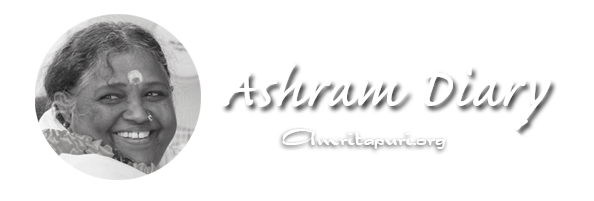Mercury News
Posted: 06/14/2009 12:01:00 AM PDT
For up to 20 hours, they wait for their hug. Devotees say the 10-second embrace is worth it, inspiring everything from simple loving reassurance to profound spiritual clarity, even a miraculous respite from aches, pains and disease.
When it comes to matters of the heart and spirit, Mata Amritanandamayi, known as Amma, or Mother, willingly hugs to heal. “My religion is love,” she says. But when it comes to ailments of the physical body, the hugging saint from India believes modern medicine is best.
Amritanandamayi has founded numerous hospitals, medical schools, hospice centers, and rural clinics throughout India. “In order to know God, it is necessary to preserve the physical instrument — the body,” she says on her Web site. “Therefore, hospitals and treatment are not incompatible with spirituality.”
Saturday marked the end of Amritanandamayi’s biannual hugathon at her ashram in Castro Valley, where she hugged more than 20,000 people during her 10-day stay. (Her total lifetime hug count has passed 27 million.) The hours-long wait, combined with the post-hug bliss, has a positive effect on visitors’ wallets. A constant flow of money is spent on saris, Amma dolls, coffee, and samosas; the proceeds of which go entirely to her charitable projects in India.
The donations aren’t just cash. When Amritanandamayi departs for the next stop on her tour, the gymnasium-size warehouse, currently lined with dining tables and hungry hug-ees
Advertisement
hunched over plates of curry and rice, will be converted back to a den of gurneys, wheelchairs, and boxes of catheters, syringes and pills.
Seven days a week, Lela Kudritzki, who lives at the Castro Valley ashram, collects and inventories the donated medical supplies stacked on pallets throughout the warehouse. Hospitals, private doctors, dentists, and hospice care centers throughout the Bay Area, including Kaiser Permanente Santa Clara and Kaiser Permanente San Jose medical centers and Orchard International in Mountain View, call Kudritzki to pick up excess supplies.
“All hospitals have a lot of equipment,” Kudritzki said. “Sometimes they order too much or the doctor who used it moved to another hospital. Most often they change brand names.”
Other times, surplus accumulates when a hospital changes policies, like switching from latex gloves to nonlatex gloves, when they update equipment, or when pharmaceuticals near their expiration date, but are still safe.
Sixty percent of the supplies will be shipped to the Amrita Institute of Medical Science (AIMS), Amritanandamayi’s main charitable hospital in India. Another group, Los Medicos Voladores, or Flying Doctors, based in San Jose, takes the remaining 40 percent with them on medical service visits to Mexico and Central America.
Amma started her first hospital, AIMS hospital, in Kerala, India, in 1990. The hospital has since grown to a 1,300-bed state-of-the-art facility with six specialty institutes — including cardiology, orthopedics, and gastroenterology — and four branch hospitals. More than half of the hospital’s services are provided free or at reduced cost to the poor.
“The hospital feels like a temple,” said Neela Penumarthy, 24, of her visit to AIMS in 2005. The second-year medical student from Palo Alto has been coming to Amritanandamayi’s ashram since she was 4. She believes the AIMS hospital model will be replicated. “The standard of care is really high.”
Many of AIMS’s doctors were recruited from top U.S. hospitals, and medical volunteers often go there to consult. The hospitals’ reputation has caught the attention of many foreigners who travel there for surgeries that are astronomically expensive in their home countries.
“We can do bypass surgery for approximately $3,000,” said Ron Gottsegen, who lives part of the year in India and part of the year at the ashram. Fees from foreigners’ surgeries subsidize the care for the poor, he said.
Amritanandamayi’s volunteers have made significant contributions to various programs in India, including telemedicine and electronic medical records. Gottsegen helped develop a computerized record-keeping system that is now used in all of Amritanandamayi’s medical centers throughout India. He and a team of volunteer software engineers from India and California are adapting it for use in the U.S. health care system. If they can win a piece of the federal stimulus funding earmarked for electronic health records, they hope to compete with other top developers.
“If we do our job, we’ll become one of the effective partners in the industry,” Gottsegen said.
Penumarthy said Amritanandamayi’s commitment to serving the poor and her straightforward approach to solving health problems made her want to become a doctor and work in the developing world. Her friend Srividya Sheshadri, 26, of Cupertino decided to become a social worker and Ameya Ananth, 22, of San Jose, will train to be a public-interest lawyer. The three of them have been coming to the ashram with their parents for decades, donating their time to her various projects.
“Once Amma touches your heart, watch out,” Sheshadri said. “You just melt. Then you’re inspired to follow her example.”
http://www.mercurynews.com/ci_12581124?&nclick_check=1



Leave a Reply
You must be logged in to post a comment.